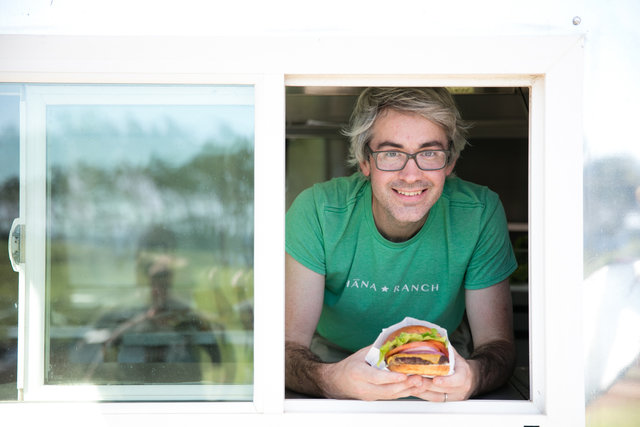Hana Ranch enlists help to pursue sustainability

COURTESY HANA RANCH
Pippa Harriman, works the Farmstand at Hana Ranch where organic produce and ranch products are sold 9 a.m. to 3 p.m. Mondays to Fridays.

COURTESY MOLLY DECOURDREAUX / HANA RANCH
Morgan Maki holds one of the burgers that will be available when the ranch’s food truck opens this summer.


“Business” can sound like a dirty word in relationship to the environment, but it takes more than hiring a chef and setting up a few tables to run a restaurant. The survival of Hana Ranch starts with Bio-Logical Capital, a company that brings a businesslike approach to sustainability.
Noting that Hawaii imports more than 85 percent of its food, Bio-Logical Capital purchased the mauka portion of Hana Ranch in 2014. It brought together leaders in environmental science, conservation, land and community planning, renewable energy, sustainable agriculture, finance, real estate development and project management, with the goal of coming up with ideas that, if successful in Hawaii, might be duplicated by farms around the globe.
An April 29 Poi Supper at Hana Ranch, held in the spirit of sitting at the table to share food and knowledge with family and community, will benefit the nonprofit Hana Youth Center.
The 4 to 6 p.m. event is part of the 24th annual Taro Festival, a partnership of Hana Ranch, Edible Hawaiian Islands and Travaasa Hana.
The meal will feature pupu and Koloa Rum cocktails created by Matthew Biancaniello, a mixologist from Los Angeles; a Hana Ranch farm tour with manager Angie McGinness; a poi-pounding demonstration by Viliami Tukuafu of Ma Ka Hana Ka ‘Ike; and a four-course dinner by Hana Ranch chef Jon Watson and Travaasa Hana chef Jay Johnson. Tickets are $95, available at hanapoisupper.eventbrite.com.
Don't miss out on what's happening!
Stay in touch with breaking news, as it happens, conveniently in your email inbox. It's FREE!
As one of Hawaii’s most isolated communities, Hana struggles with socioeconomic issues that can leave youth vulnerable to negative influences.
The Hana Youth Center, established in 1986 as an after-school drop-in center, prides itself on providing a setting free from the influences of tobacco, drugs and violence, and where Hawaiian values are promoted.
To get the Hana Ranch Provisions restaurant and other hospitality enterprises running, the company enlisted Morgan Maki, a food service and sustainability specialist and educator, who worked at several San Francisco restaurants before taking deeper interest in the environmental and community aspects of food production. His wife, Linh Phu, is a pastry chef who developed and manages the pastry program at Provisions.
While working for Bi-Rite Market in San Francisco, Maki helped create 18 Reasons, a nonprofit food education space that brought farmers, food producers and the community together to learn about and prepare food.
As retail manager at Hana Ranch, he is the link between kitchen and farm personnel who might not see eye to eye because they don’t share the same pressures.
“The kitchen wants consistency so chefs can plan their menus, and the environmental aspects of production are foreign to someone who spends time in a hot kitchen,” Maki said.
A chef may demand more tomatoes or other ingredients, but a farmer cannot force to them to grow on cue. Those are among the challenges of running a restaurant like Hana Ranch Provisions, which relies mostly on a single source, sister company Hana Ranch, for its produce.
“There’s similarity in the physicality and tenacity of their work,” Maki said, “but most of the time it’s like they’re working in two separate silos and I have to make sure each is aware of the others’ workload, and that they understand the value of each other’s work.”
Lessons learned on the ranch will inform future projects, and Maki said the outside world has much to gain from the example set by ancient Hawaiians.
“The Hawaiians had a sophisticated system,” he said of the ancient ahupuaa division of land into narrow wedges that ran from mountain to sea. Taking into account each region’s abundance and population, each section was sized accordingly to be self-sustaining, providing its residents with a full range of natural resources.
At the heart of the system was the knowledge of the inter-relationship between man and nature and achieving a perfect balance between the two. The ahupuaa system was able to sustain a pre-contact population of about 1 million people, comparable to Oahu’s population today.
“We’re looking at the past to shape the future,” Maki said, adding that in spite of good intentions, it will take much work and willpower to change systems already in place.
“Shippers make money by importing 90 percent of food, so there’s lots of money tied into the status quo. But alternatives will become important as food safety and fuel cost issues become more critical.”





